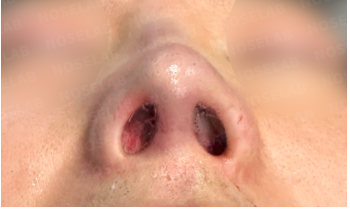Case Study: Hump Nose Revision and Asymmetry Correction – Rhinoplasty Korea
- noselab
- 2024년 11월 21일
- 2분 분량
최종 수정일: 9월 26일
Hello, this is Dr. Cha-Young Kang, Director of Nose Lab Clinic.
Today, I’d like to share the case of a patient who underwent hump nose revision surgery after structural issues and asymmetry developed following a previous hump nose correction. This case highlights the importance of careful planning and precision in revision rhinoplasty.
1. Patient History and Goals
The patient had hump nose correction along with deviated septum and rhinitis surgery in 2017 at another clinic. Afterward, the patient experienced an uneven nasal bridge, nostril asymmetry, and an upturned nose. The primary goal of this hump nose revision was to achieve natural and symmetrical results that would prevent further surgeries.

2. Diagnosis and Surgical Plan
Upon examination, the following issues were identified:
Septal cartilage damage causing a tilted columella
Overcorrection at the keystone area, leading to nasal instability

Saddle nose deformity caused by prior cartilage damage
Surgical Plan for Hump Nose Revision:
Osteotomy to straighten and narrow the nose
Rib cartilage grafting on the right anterior nasal spine for stability
Septal deviation correction by shifting the septum to the right
Columella scar tissue removal to smooth the nasal tip
Keystone reconstruction to restore structural stability




3. Surgical Outcomes and Patient Feedback
Front View:Nostrils appeared less exposed, and the previously uneven bridge became smoother.
Side View:The saddle nose deformity was corrected, restoring balance to the nasal bridge and creating a natural nasolabial angle. Lip protrusion also improved.

Overall Contour:A sleek, natural bridge complemented the facial features.
Nostril View:Asymmetry was significantly reduced, with the columella repositioned symmetrically.


4. Key Considerations in Hump Nose Revision
Revision surgery for hump nose correction requires balancing aesthetics with nasal structure. Overcorrection can destabilize the nose, causing asymmetry, collapse, or breathing problems.
The keystone area is especially critical; it must be preserved or reconstructed for long-term stability. Augmenting with rib cartilage or implants when necessary ensures structural integrity without compromising the natural look.
5. Conclusion
Hump nose revision and asymmetry correction are complex but rewarding when approached with precision and expertise. At Nose Lab Clinic, we create tailored solutions to restore both beauty and function, ensuring natural, long-lasting results.
If you are considering revision rhinoplasty, consult experienced specialists to design a personalized treatment plan.
Thank you for reading. This is Dr. Cha-Young Kang from Nose Lab Clinic.
Nose Lab performs all surgeries using the closed rhinoplasty technique.

Messenger(WhatsApp) : +82 1057360302
Home page : www.noselab.co.kr
Instagram : noselab_global
YouTube : Noselab
Email : noselab@naver.com



댓글